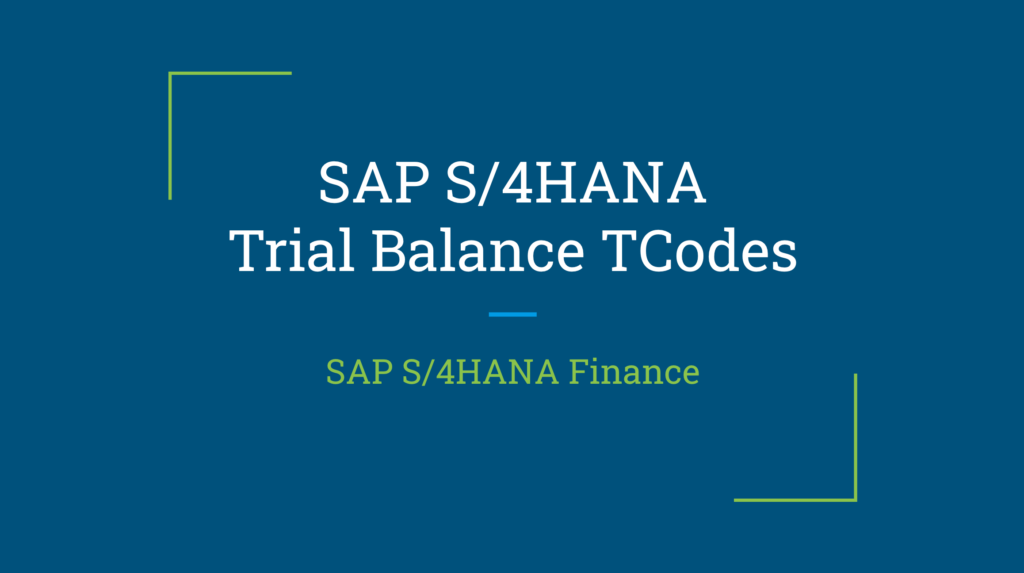Trial balance is a crucial step in the accounting process, ensuring accuracy and balance in financial statements. In this blog post, we will explore the concept of trial balance and guide you through the essential Trial Balance SAP Tcodes to achieve an accurate and error-free trial balance.

Table of Contents
Understanding Trial Balance
Trial balance is a statement that lists all the general ledger accounts and their respective debit or credit balances. Its primary purpose is to ensure that the total debits equal the total credits, thus verifying the accuracy of the accounting records.
SAP S/4HANA, being a leading ERP system, offers several transaction codes (Tcodes) and SAP Fiori Apps that streamline this process and help accountants maintain control over their financial data.
Trial Balance SAP Tcodes
Following is the list of important trial balance SAP tcodes.
1. SAP Tcode: FS10N (G/A Account Balance Display)
FS10N transaction code provides a comprehensive view of the G/L account balances. It allows you to view the balances for specific company codes, fiscal years, G/L account number and other relevant parameters. With FS10N, you can easily identify any imbalances between debits and credits. FS10NA tcode can also be used to display the G/L account balances.
2. SAP Tcode: F.01 (Financial Statements)
F.01 enables you to generate financial statements, including the balance sheet and profit and loss statement. By specifying the relevant parameters, such as the fiscal year and company code, you can obtain an accurate overview of your financial position. Following are the mandatory parameters to execute the finance statement.
- Financial statement version
- Reporting Year
- Reporting Periods
- Comparison Year
- Comparison Periods
3. SAP Tcode: FBL3N (G/L Account Line Item Display)
FBL3N provides a detailed display of the line items for one or more G/L accounts. Using this tcode you can also view open items, which are not yet been cleared and cleared items. This allows you to review individual transactions and identify any discrepancies or errors that may impact the trial balance.
Following are the parameters of the FBL3N tcode
- G/L Account Number
- Company Code
- Fiscal Year
- Ledger
- Select Closing/Opening Postings at Year End
In FBL3N (G/L Account Line Item Display), documents posted with BSTAT = ‘U’ are not displayed which is based on BSEG but displayed in FAGLL03 (G/L Account Line Item Display G/L View) tcode.
4. SAP Tcode: FAGLL03 (G/L Account Line Item Display G/L View)
FAGLL03 report displays list of line items of one or more G/L accounts with G/L view and entry view.
5. SAP Tcode: F.13 (Automatic Clearing)
F.13 is a useful SAP Tcode for automating the clearing of open items in accounts receivable and accounts payable. By ensuring that all open items are properly cleared, you can maintain a balanced trial balance.
Following are the important parameters of the report:
- Company Code
- Fiscal Year
- Assignment
- Document Number
- Posting Date
- Clearing Date
- Test Run
5. SAP Tcode: FAGLB03 (Display balances in local currency)
FAGLB03 offers a comprehensive view of general ledger account balances in the local currency. This Tcode is especially useful for multinational companies operating in different currencies, as it helps maintain a balanced trial balance across various currency systems.
Best Practices for Trial Balance in SAP
To ensure a smooth trial balance process, consider implementing these best practices:
1. Regularly reconcile accounts: Perform periodic reconciliations between the general ledger and subsidiary ledgers to identify and resolve discrepancies promptly.
2. Review and analyze variances: Investigate any significant variances between the trial balance and financial statements to identify potential errors or irregularities.
3. Document and explain adjustments: Document and provide explanations for any adjusting entries made to the trial balance, ensuring transparency and auditability.
4. Conduct periodic reviews: Regularly review the trial balance to identify trends, potential errors, or areas for improvement.
Other Trial Balance TCodes
| S_ALR_87101088 | Trial Balance: Down Payments Made |
| S_ALR_87101090 | Trial Balance: Security Deposits |
| S_ALR_87101098 | Trial Balance: Bills Receivable |
| S_ALR_87101104 | Trial Balance: Guarantees |
| /SAPCE/FKGR_TRIALBLN | Accnts Rec. Trial Balance (Greece) |
| /SAPCE/FKPL_TRIBAL | Trial Balance Report (Poland) |
| FISA_TBR12 | Trial Balance – Form 12 |
| /BGLOCS/MAT_TRB | Material Trial Balance for Bulgaria |
| /BGLOCS/TRB | Bulgarian Trial Balance / T-Report |
| J1GTBD | Customer Trial Balance |
| J1GTBG | Ledger Trial Balance |
| J1GTBK | Vendor Trial Balance |
| FIQA_TB | QA Trial Balances |
| /CEECV/ROFI16 | Trial Balance at profit center level |
| /CEECV/ROFI16_O | Trial Balance at profit center level-old GL |
| /PRA/PP_RUN_ANALYSIS | Trial Check Run Analysis |
| ORMXT04 | Custom: Field Selection for Trial Views |
| ORMXTNR | Maintain Number Ranges for Trials |
| ORMXTQMBBIDNR | Maintain Number Ranges for Trials |
| RMXTPLAN02 | Change Trial Planning |
| RMXTPLAN03 | Display Trial Planning |
| FMFG_E_TP1 | Trial Balance Tie-Points |
| FMFGTB | US Federal: Trial Balance Report |
| RFACTS1_BL | FACTS 1: Trial Balance |
| RFACTS2_BL | FACTS 2: Trial Balance |
Conclusion
Mastering trial balance within SAP using the relevant Tcodes is essential for maintaining accurate financial records. By leveraging trial balance SAP Tcodes such as FS10N, F.01, FBL3N, F.13, and FAGLB03, you can streamline the trial balance process, identify discrepancies, and ensure financial integrity. Remember to follow best practices and conduct regular reviews to maintain a balanced trial balance and make informed financial decisions.




